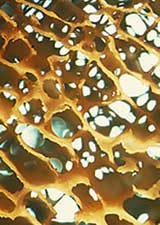Material bones up

Molecular scaffolding makes for good bone structure. <br>© SPL
Programmed molecules build themselves into a bone-mimic.
Scientists in the United States have made self-assembling synthetic bone1. Carefully designed building-blocks join up to mimic bone’s complex molecular-scale architecture, bringing better prosthetics a step closer.
Materials engineers are keen to emulate the strength and toughness of biominerals such as bone, tooth and shell. Mollusc shells, for example, a composite of the mineral calcium carbonate and sheets of organic tissue, are much tougher than an equivalent slab of the mineral alone. So, like a biomineral, the bone-mimic is a blend of hard mineral-like substances and soft organic ones.
Bone is a composite of the calcium-containing mineral hydroxyapatite and the protein collagen, the tough fibrous component of tendons and ligaments. Collagen fibres provide a scaffold on which hydroxyapatite crystals gather, conferring hardness.
Each collagen fibre is itself a delicately wrought cable of several string-like protein molecules. The fibres assemble spontaneously like pre-programmed girders. These hold the hydroxyapatite crystals together and govern the orientation of the stacked sheets of atoms in the crystals, enhancing the material’s strength.
Sam Stupp and colleagues of Northwestern University in Illinois have tailor-made small protein-like molecules called peptides. To each peptide they attached a tail that was insoluble in water, encouraging them to assemble into cylindrical columns with their tails pointing inwards, shielded from water.
These long, flexible columns formed a tangle of worm-like fibres. Stupp’s team fixed the fibres in place by bonding adjacent peptides on their surfaces. Similar bonds link collagen fibres into the connective tissue between cells.
The team also included molecular groups such as those that promote hydroxyapatite crystal formation in natural proteins. Finally, they added groups that make proteins stick to cells. These, they reasoned, would allow the self-assembling web to harbour living cells.
The researchers put this matrix in a solution of ions – primarily calcium and phosphate. Hydroxyapatite crystals grew on the scaffold; their atomic layers aligned with the fibres, just as they do on the collagen scaffold of bone.
References
- Hartgerink, J. D., Beniash, E. & Stupp, S. I. Self-assembly and mineralization of peptide-amphiphile nanofibers. Science, Published online 22 November (2001).
Media Contact
More Information:
http://www.nature.com/nsu/011129/011129-3.htmlAll latest news from the category: Materials Sciences
Materials management deals with the research, development, manufacturing and processing of raw and industrial materials. Key aspects here are biological and medical issues, which play an increasingly important role in this field.
innovations-report offers in-depth articles related to the development and application of materials and the structure and properties of new materials.
Newest articles

A universal framework for spatial biology
SpatialData is a freely accessible tool to unify and integrate data from different omics technologies accounting for spatial information, which can provide holistic insights into health and disease. Biological processes…

How complex biological processes arise
A $20 million grant from the U.S. National Science Foundation (NSF) will support the establishment and operation of the National Synthesis Center for Emergence in the Molecular and Cellular Sciences (NCEMS) at…

Airborne single-photon lidar system achieves high-resolution 3D imaging
Compact, low-power system opens doors for photon-efficient drone and satellite-based environmental monitoring and mapping. Researchers have developed a compact and lightweight single-photon airborne lidar system that can acquire high-resolution 3D…





















